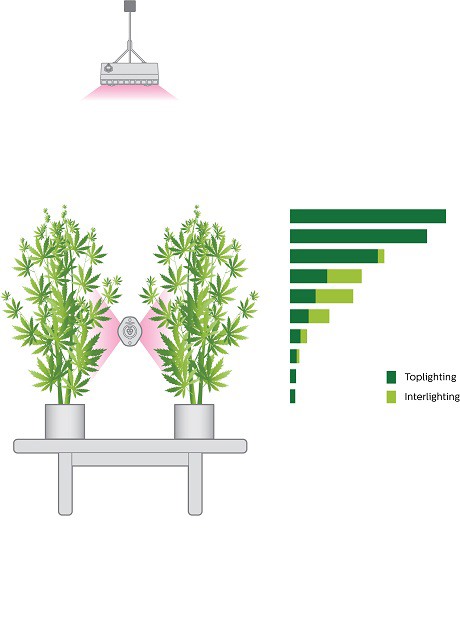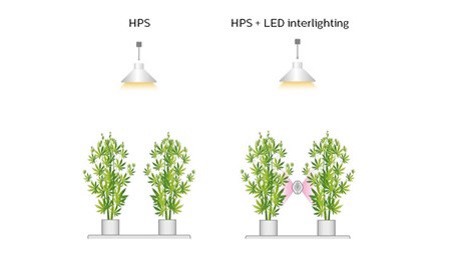Cannabis is a light-loving crop. Light levels up to 1000 mmol/m2/s in indoor facilities are fairly common. However, with the use of grow lights at the top of the greenhouse or indoors, that light is only accessible at the highest part of the crop because of the density of the leaves of the plant. Intercanopy lighting spreads the light more evenly over the canopy and in the middle part of the crop which increases flower development.
How does intercanopy LED work for your cannabis crop?
The visual shows that the top layer of the canopy absorbs most of the daylight and/or toplighting and the light level quickly decreases further downwards in the crop. This typically results in smaller flowers and slower maturity, which is disadvantageous to the potency development lower in the canopy and therefor influences the total crop quality.
 Light distribution over the crop combining LED toplighting + LED interlighting
Light distribution over the crop combining LED toplighting + LED interlighting
Inspired by the scientific study of Haley et al 2018, growers using Signify LED interlighting aim to get a more uniform cannabinoid profile. The use of Philips LED interlighting has led to a more uniform flower and potency development in the lower part of the canopy. Besides, it raises the total production due to better flower development over the total height of the plant, which then results in a higher total yield by raising the quality of the flowers lower in the canopy. Intercanopy lighting can easily be combined with either HPS or Philips LED toplighting.
Interlighting can be implemented as an additional lighting source in current existing Cannabis cultivation setups. Quick and easy installation makes it possible to run the lights in your next crop cycle.
The following test setup has been executed under practical circumstances bringing the following results on difference between HPS and the hybrid system HPS with interlighting.
Research benefits of LED interlighting
Through research in customer production facilities, we have seen a big impact of using LED interlighting in the cannabis crop. Not only have we noticed that the leaves look healthier, but also have we seen that the leaves stay healthier throughout the cycle of the crop. This directly drives photosynthesis and results in a more efficient production. Second, we’ve measured a higher dry flower weight; the crop with HPS ended up at 0.27 gram/mol* and HPS + interlighting ended up at 0.37 gram/mol*. And third, due to the healthier leaves, 30% less crop maintenance could be achieved as significant less de-leafing was required.
 Comparison HPS only and HPS + LED intercanopy lighting
Comparison HPS only and HPS + LED intercanopy lighting
More ‘A’ class flowers & higher THC levels
The quality of the medical cannabis crop is measured on a couple of characteristics. One of them being the amount of A, B or C class flowers, with A being the best. Throughout the trial we have measured the dry flowers from the crop; how many flowers could we grow in class A, B or C. A big differences were seen between the HPS crop and the HPS + LED interlighting crop. The traditional system with HPS produced a mixture of A, B and C class flowers. The hybrid system produced mainly A class flowers. And second, next to the larger amount of A class flowers, we’ve also seen an increase on compound level. The hybrid lighting setup including the LED interlighting shows a 5% higher THC value (sampled on a mixture of flowers from top to bottom) compared to the HPS.
Proven results with LED interlighting
Intercanopy lighting serves to bring light in the lower, darker areas of the crop, spreading the light more evenly over the canopy. Medicinal cannabis growers are now experiencing the value of intercanopy lighting as well. Intercanopy lighting has already proven itself for high-wire tomato and cucumber production with hundreds of hectares sold worldwide.
For more information:
Signify Global Marcom Horticulture
Daniela Damoiseaux
+31 6 31 65 29 69
daniela.damoiseaux@signify.com
philips.com/horti
